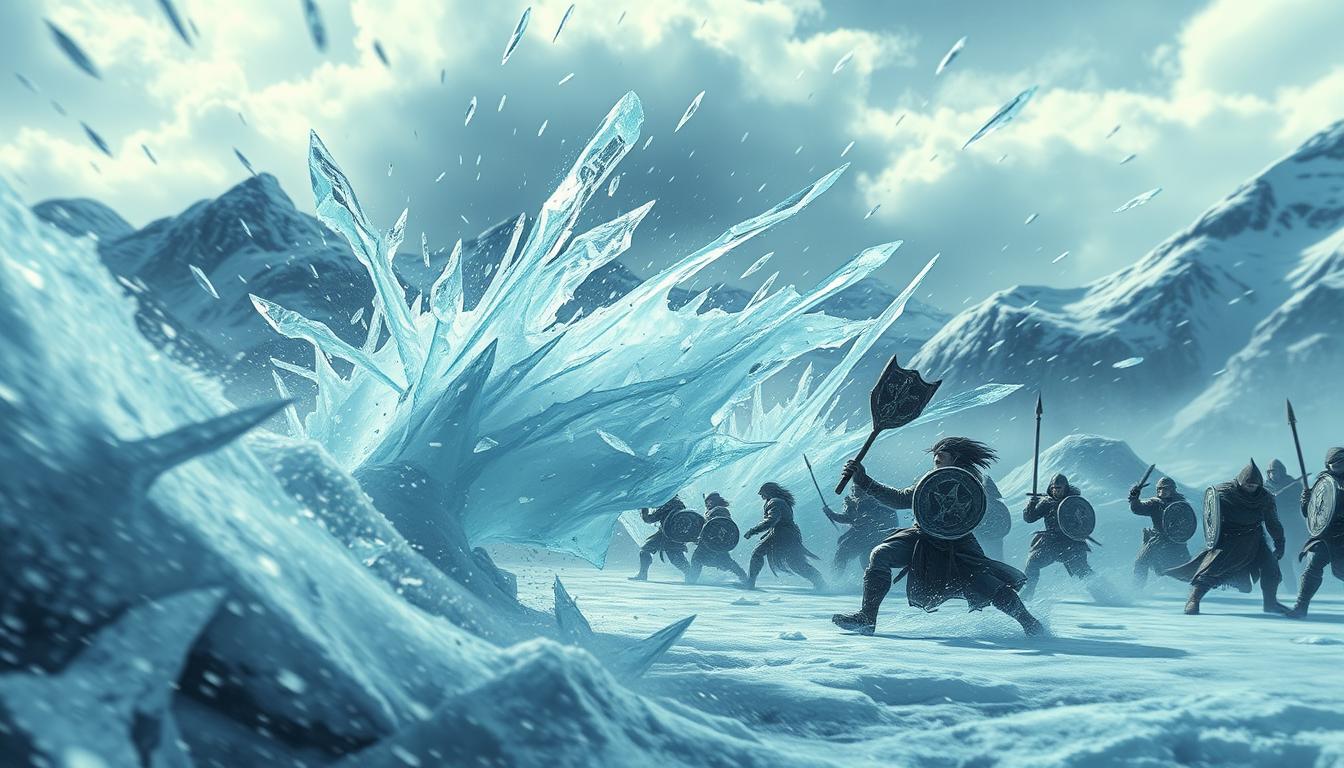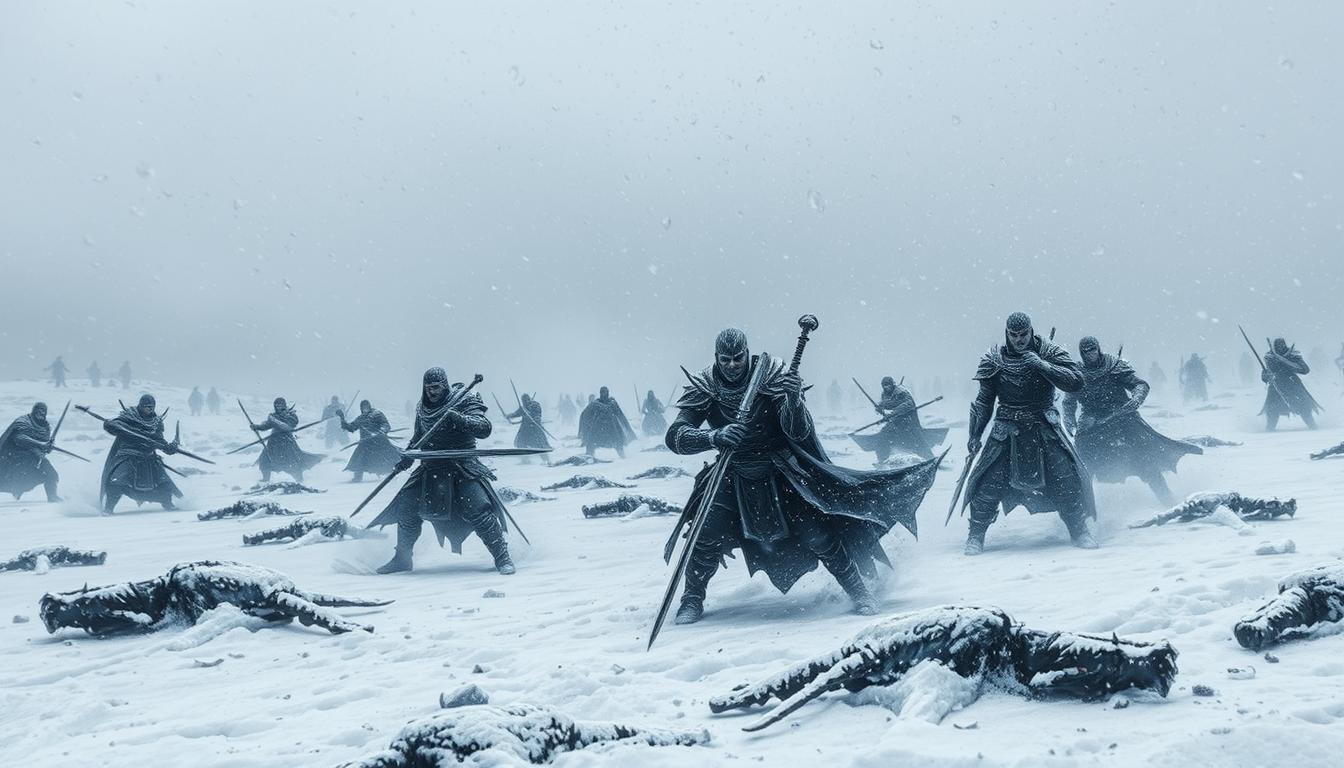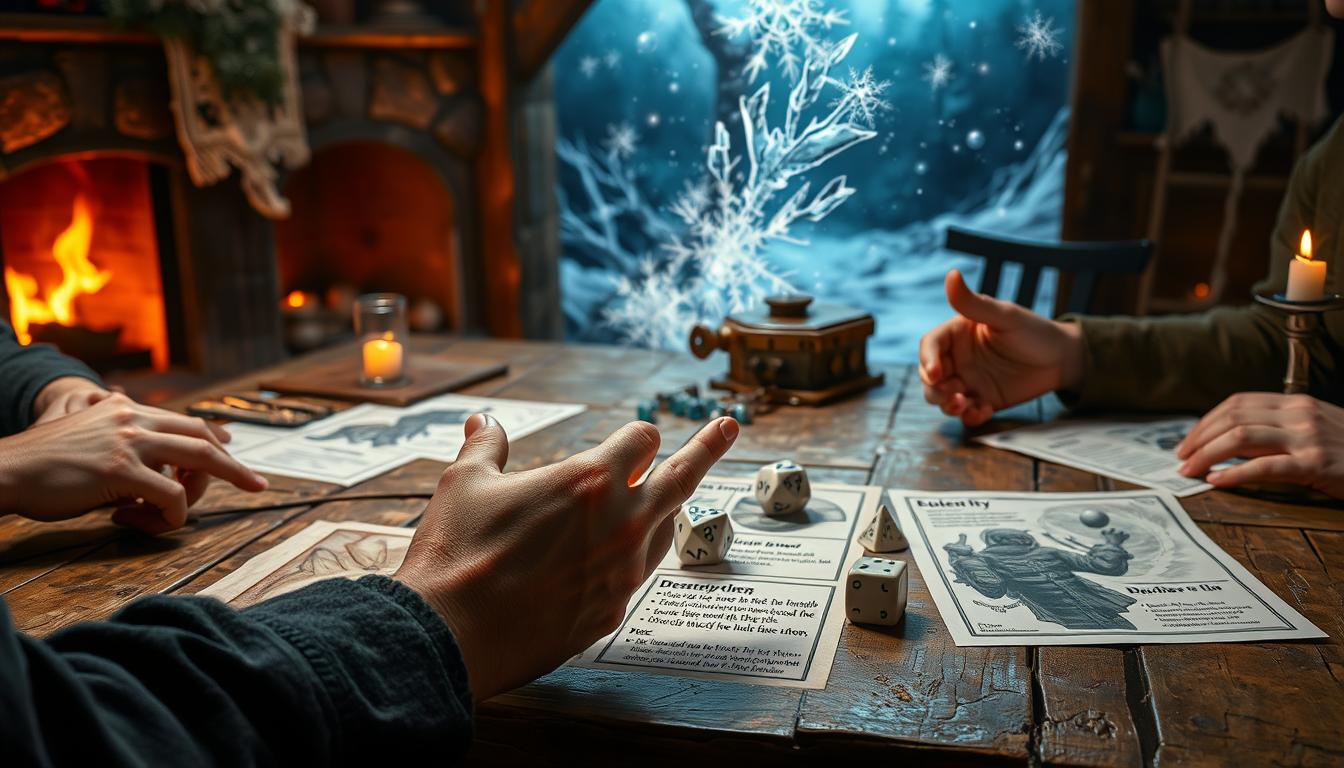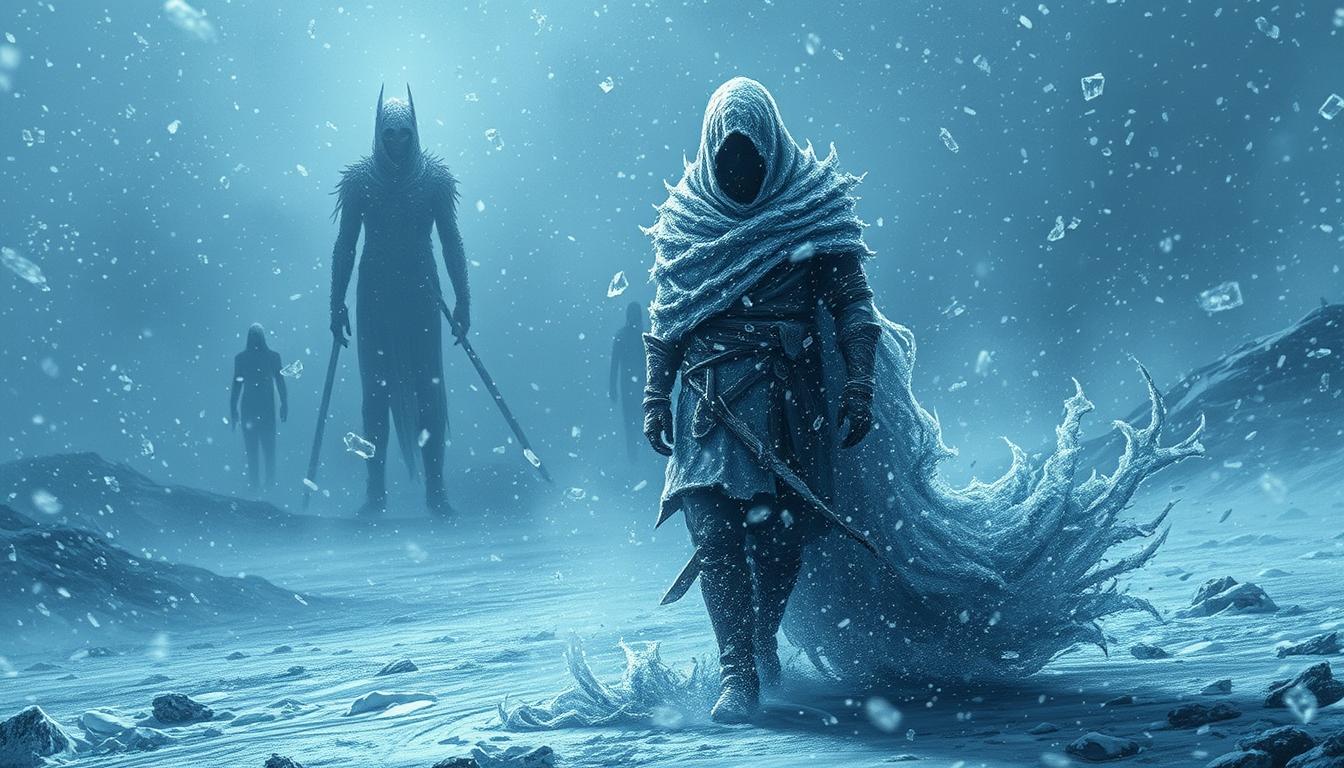Sleet Storm 5e: My Firsthand Account and Survival Tips

Ever faced a battle where one wrong move meant disaster? I did—when my party got caught in a sleet storm during a high-stakes Dungeons & Dragons campaign. The icy chaos nearly wiped us out, but it also taught me invaluable lessons.
This spell isn’t just about freezing the ground. It’s a tactical game-changer. Whether you’re a DM or a player, understanding its mechanics can turn the tide of combat. I’ll share how I survived and how you can too.
From raw rules to real-play strategies, this guide blends theory with hard-earned experience. Ready to master this powerful spell? Let’s dive in.
Key Takeaways
- Learn how to use the spell effectively in combat.
- Discover tactical advantages beyond the rulebook.
- Avoid common mistakes that could cost your party.
- Combine mechanics with creative battlefield control.
- Adapt strategies for different campaign scenarios.
Introduction: My Brush with Sleet Storm 5e
One moment we were advancing—the next, a whirlwind of freezing rain swallowed us whole. Our party caught sleet storm mid-charge, and the effects were instant. The howling wind drowned out commands, and ice pellets stung like daggers. I couldn’t see my own hand in front of me.
Movement became a gamble. Every step risked slipping, and attacks missed wildly. Our rogue face-planted trying to flank. The wizard’s firebolt fizzled in the icy deluge. Combat turned into survival mode.
We adapted fast. The cleric cast Guidance to steady our footing. I used the chaos to reposition, letting the storm shield us from arrows. By the end, I wasn’t just enduring it—I was exploiting it.
That fight taught me more than any rulebook. Now, I wield this spell like a scalpel. But first, let’s break down how it works.
What Is Sleet Storm 5e?
Nothing reshapes a battlefield faster than a well-placed conjuration spell. Sleet storm is a 3rd-level spell that turns a 40-foot-tall, 20-foot-radius area into a frozen nightmare. Druids, sorcerers, and wizards unlock it at 5th level, and trust me—it’s worth the slot.
Spell Overview
This icy tempest packs triple-threat effects: heavy obscurement, difficult terrain, and concentration checks for anyone inside. Casting it takes one action, and maintaining the chaos requires concentration for up to a minute. The range? A generous 150 feet—perfect for sniping enemy backlines.
Key Components
You’ll need verbal, somatic, and a quirky material component: a pinch of dust from a crushed miniature umbrella. In my last campaign, our wizard forgot his and used a cocktail umbrella instead—the DM allowed it, but the storm rained tiny paper umbrellas. Rulebook purists groaned, but the table laughed.
Here’s why this spell stands out:
- Obscurement: Blocks vision like a blizzard, forcing ranged attacks to guess.
- Terrain control: Movement costs double, crippling melee foes.
- Spellbreaker: Enemies make Con saves or be dropped spells.
How Sleet Storm Works
Timing is everything when you drop an icy tempest mid-combat. The effects cascade each round, forcing enemies to adapt or fall. Here’s how the chaos unfolds.

Mechanics Explained
When the spell activates, creatures inside the area must make a saving throw (Dexterity) or fall prone. This happens both when they enter the zone and start their turn there. I’ve seen entire ambushes fail because rogues spent actions standing up.
Prone enemies burn half their movement just to rise. Melee attackers get disadvantage, while ranged foes struggle to target obscured allies. It’s a brutal action-tax.
Dexterity Saving Throw
Targeting low-Dex foes like armored knights? This spell shines. But remember: high-Dex enemies often escape the prone condition. That’s why I position the cylinder’s edge near key targets—forcing them to choose between retreat or repeated saves.
Cast spellcasters? They’ll hate you. Every round inside triggers a Constitution save to maintain concentration. I once disrupted a boss’s Hold Person with this, saving our paladin from paralysis.
The Power of Sleet Storm
Few spells reshape combat like this icy battlefield dominator. It doesn’t just slow enemies—it rewrites the rules of engagement. Here’s why it’s a must-have for tactical players.
Heavy Obscurement
Inside the spell’s area, visibility drops to zero. Ranged attackers guess blindly, and spells requiring line of sight fizzle. But it’s not invisibility—allies suffer too unless they’ve got blindsight.
Roll20’s rules clarify: obscurement stacks with existing difficult terrain. Drop this on a muddy ground, and movement becomes a nightmare. My party once trapped a cavalry charge this way—horses slid into each other like bowling pins.
Difficult Terrain
Every step costs double movement. Combine that with prone effects, and melee foes waste turns standing up. Here’s how it breaks down:
| Condition | Movement Cost | Save Required |
|---|---|---|
| Difficult Terrain | 2x Normal | None |
| Prone | +½ Movement | Dexterity |
| Both | 2.5x Normal | Dexterity |
Pro Tip: Cast this near cliffs or lava. Enemies failing saves might just slide to their doom.
- Obscurement vs. Blindness: Doesn’t grant advantage/disadvantage like blindness—just blocks vision.
- Ranged Dynamics: Archers must target a square, not a creature.
- Environmental Combos: Oil patches become icy death traps.
Strategic Uses of Sleet Storm
Controlling the battlefield isn’t just about damage—it’s about dictating movement. This spell excels at both. Whether you’re herding enemies into traps or protecting allies, its layered effects make it a Swiss Army knife for crowd control.
Crowd Control
Narrow dungeon corridors become death traps with this spell. I once funneled a horde of goblins into a 10-foot choke point. They spent turns slipping while our rogue picked them off. Pro tip: Cast it at bottlenecks to maximize chaos.
Squishy party members? Shield them by dropping the storm between them and melee foes. The obscurement forces enemies to waste actions repositioning.
Countering Spellcasters
Ever faced an archmage? Their +1 CON save won’t save them here. Every round inside triggers a concentration check. I’ve watched enemy healers drop spells mid-cast because they couldn’t beat the DC.
Lesson learned: Position the storm’s edge near casters. They’ll either retreat or risk losing their best level slots. Just don’t misjudge the range—like I did, letting a warlock counterspell me from safety.
Synergies with Other Spells
Combining spells can turn a chaotic battlefield into a controlled playground. The right pairings amplify damage, lockdown foes, or exploit environmental hazards. Here’s how to make your icy tempest work harder with allies’ magic.
Eldritch Blast & Repelling Blast
Warlocks with eldritch blast and the Repelling Blast invocation are a match made in tactical heaven. Each hit pushes enemies 10 feet—straight back into your icy zone. They’ll repeat Dexterity saves or eat opportunity attacks.
My party’s warlock once juggled a troll like a hockey puck. Three blasts sent it sliding 30 feet, triggering three prone checks. By the time it stood, our rogue had landed two sneak attacks.
Plant Growth and Transmute Rock
Druids wielding plant growth can layer brutal terrain effects. Normal movement costs quadruple—then add the icy slip factor. Transmute Rock (mud to stone) creates a frozen slide for hilarious (and deadly) results.
| Combo | Effect | Best Against |
|---|---|---|
| Sleet Storm + Spike Growth | 2d4 piercing damage per 5 feet moved | Melee mobs |
| Sleet Storm + Web | Restrained + prone = auto-fail Dex saves | High-Dex enemies |
Warning: Many combos require concentration. Coordinate with allies to avoid overlap. My bard learned this the hard way—his Hypnotic Pattern vanished when I dropped my storm.
- Warlock Tactics: Repelling Blast + Grasp of Hadar for pull/push chaos.
- Druid Stacking: Layer plant growth first, then drop the storm.
- Action Economy: Force enemies to waste turns standing or crawling.
Non-Spell Synergies
Ever watched a rogue turn caltrops into a frozen death trap? Martial classes and equipment add brutal creativity to icy battles. While spells get attention, smart items and feats can make your storm unstoppable.

Caltrops and Ball Bearings
Scatter these tiny terrors before casting. The storm turns them into hidden hazards. Enemies standing up from prone take automatic damage—no attack roll needed.
My rogue once coated ball bearings in grease. Combined with the spell, they created a 40-foot skating rink of pain. The DM ruled falling damage applied when ogres slid into walls.
Feats Like Crusher and Alert
The crusher feat shines here. My Dao Genie warlock would blast enemies back into the storm with Eldritch Blast. Forced movement triggers new Dexterity saves each time.
Alert grants +5 to initiative—crucial for controlling the battlefield early. It also negates unseen attacker penalties when you’re inside your own storm. No more disadvantage on those critical counterspells.
- Martial Teamwork: Fighters can shove prone enemies deeper into the zone.
- Scout Traps: Rangers mark targets for allies shooting through obscurement.
- Environmental Combos: Oil flasks become instant ice patches when the spell hits.
Remember: creativity beats raw damage. Our barbarian once threw a net into the storm. The restrained condition made Dexterity saves nearly impossible to pass.
Anti-Synergies to Avoid
Not every spell combo works as planned—some create more problems than solutions. In combat, the wrong pairing can leave your party worse off than before casting. I’ve made these mistakes so you don’t have to.
Fear and Melee Weapons
The Fear spell forces enemies to flee—right out of your icy zone. I wasted a 5th-level slot before realizing this. Melee allies then chase frightened foes, overextending into danger.
Worse? Frightened creatures have disadvantage on ability checks. That includes Dexterity saves against falling prone. Your awesome combo just became counterproductive.
Sneak Attack Limitations
Rogues need visibility for sneak attack bonuses. The spell’s heavy obscurement blocks this unless they have blindsight. Our rogue once spent three turns guessing squares before we developed hand signals.
Key conflicts to watch for:
- Vision-dependent abilities: Many class features require line of sight
- Friendly fire: Our ranger’s arrows kept hitting my back (whoops)
- Mental effects: Fear/charm spells often backfire with movement penalties
Now we establish “rogue protocols” before casting—saving everyone’s damage output and my reputation.
Sleet Storm vs. Other Crowd Control Spells
Not all crowd control spells are created equal—some shine in ways others can’t. While *hypnotic pattern* dazzles with charm effects, icy terrain offers brute-force reliability. Here’s how they stack up.
Comparison to Hypnotic Pattern
*Hypnotic pattern* charms foes, but immunity is common. Undead, fiends, and elves laugh it off. My *sleet storm*? It doesn’t care about race or level. Environmental effects always land.
Charm spells also end if allies attack. Ice stays brutal for the full minute. In one fight, a charmed ogre snapped free after our rogue stabbed it. The storm kept it slipping regardless.
Niche Advantages
Some battles demand more than charm. Against undead hordes, *sleet storm*’s power is unmatched. It also covers a 40-foot cylinder—bigger than *hypnotic pattern*’s 30-foot cube.
My tier list for crowd control:
- Undead-heavy campaigns: *Sleet storm* > *hypnotic pattern*
- Metagame counters: Counterspell-proof (no visible targets)
- Area denial: Lasts longer than most charm effects
Pro tip: Drop it on enemy spellcasters. They’ll waste turns standing or lose concentration.
Acquiring Sleet Storm
Not every caster gets access to this tool—here’s who does and why. The spell’s power hinges on your class choice, and picking the right one amplifies its chaos. I learned this after my bard fumbled with a scroll, realizing too late it wasn’t on his list.
Class Availability
Druids and wizards grab this at 5th level, but their playstyles differ. Druids lean into terrain control, while wizards exploit its synergy with arcane buffs. Sorcerers? They’re the wild cards. My storm sorcery build paired it with Heart of the Storm for extra lightning damage.
Key distinctions:
- Druids: Better for area denial with Plant Growth combos.
- Wizards: Add Slow or Web for layered lockdowns.
- Sorcerers: Metamagic like Extended Spell doubles the pain.
Multiclass Considerations
A two-level druid dip grants this ability, but delays higher-level slots. My warlock multiclassed for Repelling Blast synergy—worth it for forced movement shenanigans. Just weigh the cost: losing 3rd-level warlock spells hurt until tier 3.
Feats like Magic Initiate offer a workaround. Our rogue took it for Guidance but grabbed this spell too. Now he sets up icy ambushes before sneak attacking prone targets.
Advanced Tactics for Sleet Storm
Mastering this spell’s advanced tactics turns good players into battlefield legends. Beyond basic crowd control, it’s about exploiting every point of vulnerability. Here’s how I’ve used it to dominate aerial foes and chokeholds.
Flying Enemies
Dragons and harpies think they’re safe above the fray. Not anymore. The spell’s power forces flying creatures to land or crash. How? The icy surface counts as difficult terrain—even mid-air.
- Aerial denial: Flying creatures must land or risk falling damage.
- Reverse gravity combo: Pair with this spell to slam enemies into the ice.
- Dragon encounter: Our party grounded a young red dragon by timing the spell as it dove.
Chokepoint Control
Narrow corridors become kill zones with smart placement. I once trapped a hobgoblin warband in a 10-foot tunnel. They spent every time slipping while our wizard picked them off.
Key techniques:
- Map prep: Identify bottlenecks before combat starts.
- Layer effects: Drop caltrops first, then cast for guaranteed prone fails.
- Team coordination: Rogues can ready actions to attack anyone who stands.
Common Mistakes with Sleet Storm
Even the best spells can backfire if you overlook key details. I’ve watched allies block their own retreat or waste slots because they misunderstood the rules. Here’s how to avoid the worst pitfalls.
Overestimating Obscurement
Heavy obscurement doesn’t equal invisibility. Creatures with blindsight or truesight ignore it—a lesson I learned when a vampire lord walked straight through my spell. Keep this in mind when targeting fiends or undead.
Also, allies suffer too. Our ranger once shot me in the back because he couldn’t see through the icy haze. Now we use hand signals or *Thaumaturgy* clicks to coordinate.

Misplacing the Cylinder
The spell’s 20-foot radius is deceptively tricky. Place it poorly, and you’ll trap friends or miss key foes. I once centered it on a point too far back, letting archers pick us off from safety.
Geometry matters: the cylinder’s edge should clip high-priority targets. Force enemies to choose between retreating or risking repeated saves.
| Error | Consequence | Fix |
|---|---|---|
| Blocking exits | Party trapped | Leave 5-foot gaps |
| Ignoring surfaces | Reduced *stone* friction | Pre-cast *Grease* |
DM Ruling Variations (Always Clarify):
- Concentration checks: Some DMs rule they’re only triggered on entry.
- Prone condition: A few allow Acrobatics checks to avoid it.
- Environmental combos: Oil + ice might deal extra damage or just slow.
Sleet Storm in Different Campaigns
From horror to heists, this spell’s utility shifts dramatically. Its icy chaos bends to the campaign’s tone—whether you’re fighting vampires in Curse of Strahd or navigating urban chaos in Waterdeep Dragon Heist. Here’s how to adapt.
Against Fiends and Undead
Fiends resist cold damage, but the spell’s condition effects still land. In Barovia, I used it to disrupt a vampire spawn’s movement. The prone condition saved our paladin from a grapple.
Undead often ignore charm spells, but icy terrain? No immunity. Layer it with Spirit Guardians for a grisly meat grinder.
Low-Level Utility
At 5th level, this spell dominates. But in tier 1, creativity matters. Our party once froze a flooded tunnel to cross safely. The DM ruled the ice lasted just long enough—narrow escapes make great stories.
- Urban campaigns: Use it to block alleyways or create distractions.
- High-level scaling: Pair with Wall of Force to trap enemies inside.
- Environmental storytelling: A sudden storm hints at a druid villain’s presence.
Homebrew and Rule Variations
Rules shape the game, but creative DMs often bend them for dramatic effect. My group has experimented with dozens of condition modifications—some became permanent house rules. Here’s how we enhanced icy terrain effects beyond the handbook.
Wet Condition House Rules
Many forums debate adding a “wet” condition when combining water with cold spells. We implemented it at our table: creatures soaked by rain or rivers take +1 cold damage per die. The trade-off? Fireball deals half damage until they dry off.
Popular homebrew additions we’ve tested:
- Stacking penalties: Wet + chilled = speed halved
- Material interactions: Metal armor grants disadvantage on saves
- Drying mechanics: 1d4 rounds near heat sources
Surface Interactions
Not all floors react equally to icy spells. Our DM created a table for different materials—stone becomes slicker than wood, while sand absorbs the effect. This led to hilarious moments when our wizard froze a marble throne room mid-combat.
When negotiating homebrew:
- Start small: Test one modification per session
- Third-party supplements: Kobold Press’s Deep Magic offers great cold spell variants
- Player buy-in: Our barbarian demanded fire resistance after three icy encounters
Remember: house rules should enhance fun, not complexity. Our table’s cold vulnerability variant (creatures take -2 to Dex saves if already chilled) took three iterations to balance.
My Top Sleet Storm Survival Tips
After dozens of battles using this spell, I’ve distilled hard-won lessons into these essential tips. Whether you’re controlling chokepoints or escaping ambushes, smart positioning and communication make all the difference. These strategies saved my party more times than I can count.

Positioning Yourself
Action economy decides battles. I follow the 3-2-1 rule: 30 feet from allies, 20 feet from the storm’s edge, and always 1 escape route. This keeps me safe while maintaining control.
Post-cast movement matters most. I ready Misty Step or position behind cover before casting. Enemies often target the caster first when chaos erupts.
| Position | Advantage | Risk |
|---|---|---|
| Flanking Edge | Easy retreat | Exposed to ranged |
| Center Rear | Protected | Blocks allies |
| Elevated | Vision | No cover |
Team Communication
Verbal components become useless mid-storm. We developed hand signals—two fingers up means “fall back,” while a fist signals “hold position.” Nonverbal cues prevent friendly fire incidents.
Always plan escape routes before casting. I mark two exits with items like chalk or torches. When the time comes to retreat, everyone knows where to go without discussion.
During one combat, our barbarian’s shout of “left!” saved three allies from sliding into a pit. Clear calls during enemy turn transitions prevent disasters.
- Pre-combat briefs: 10 seconds explaining storm boundaries prevents chaos
- Contingency signals: Thaumaturgy booms for emergency repositioning
- Post-storm reset: Designate rally points before dissolving the effect
Conclusion: Mastering Sleet Storm 5e
Magic becomes art when you turn terrain into a weapon. This spell isn’t just about freezing foes—it’s about rewriting the battlefield’s rules. Layer obscurement with forced movement, and watch enemies flounder.
Experiment fearlessly. Pair it with Web for lockdowns, or drop it on casters to break concentration. In urban campaigns, use it to block alleys. Against undead? It’s a rare condition they can’t ignore.
Last month, our level 15 party trapped a demon lord in his own lair. The sleet storm kept him prone while our paladin landed the final blow. That’s the power of control.
Now it’s your turn. How will you wield the ice?